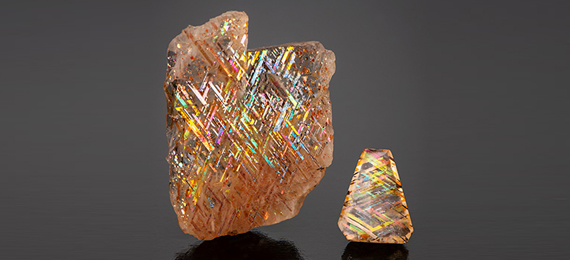
What Is Rainbow Lattice Sunstone?
Rainbow Lattice Sunstone is one of the rarest stones in the world that exhibits a rare combination of aventurescence, adularescence and a distinctive iridescence lattice pattern. The aventurescence in the stone is caused by small inclusions of a mineral with a highly reflective surface. Aventurescence creates a sparkly, metallic-looking luster which is caused by flat, reflective inclusions. Adularescnece in the stone is an optical phenomenon exhibiting a sheen or schiller effect which is caused by the below surface of a stone. The colours seen in the stone depends on the thickness of the layers. Both aventurescence and adularescence are hard to find in the same stone. Australian Rainbow Lattice Sunstone is a must-have in your rare gem collection.
Here Are a Few Rainbow Lattice Sunstone Facts
- Rainbow lattice is from a remote place in the Australian desert named mud tank zircon field.
- The striking stone was encountered in the Riverpark Inn.
- The supply of the stone is extremely limited and the only source is the tiny Utnerrengate mine in Australia.
- The mine owners restrain themselves by revealing the exact location.
- The stone was discovered by Darren Arthur and Sonny Manson in 1985 and it was acknowledged as a new material in 1989.
- At first, it was described as a type of feldspar- Moonstone with 75% orthoclase and 25% albite.
- Over the last 3 decades, the development in technology has found the black blades and triangle inclusions in Rainbow Lattice to be magnetite.
- Good original quality rainbow lattice comes from only one place in the entire world.
- Rainbow lattice material is difficult to work and it also has a lot of cracks so it is hard to find the perfect size and clean pieces.
- The pricing of the rainbow lattice has increased over the past few years.
- Rainbow lattice grows under extreme heat and pressure from old rocks.
- The lattice appearance is caused by inclusions of hematite and magnetite.